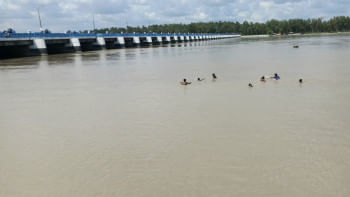Wild elephants in danger

A big portion of the wild elephant population in southern Cox’s Bazar is at risk of being wiped out, experts say.
The mammals are confined to small patches of hilly forests in Inani-Shilkhali area as Rohingya settlements have taken over their migration corridors that lead to parts of Bandarban and Myanmar.
Elephant corridors are strips of land that the large animals use to move from one habitat patch to another.
According to the 2016 elephant census conducted by the International Union for Conservation of Nature (IUCN), 63 wild elephants were found in the south forest division of Cox’s Bazar while another 205 were spotted in the country’s other regions, including Bandarban, Sherpur and Mymensingh.
The elephant is a critically endangered species in Bangladesh, shows the IUCN Red List of Threatened Species.
“Twenty percent of all wild elephants are found in this forest [the south division]… If the government does not act to save them, we fear these elephants will be wiped out from there,” said MA Aziz of the zoology department at Jahangirnagar University, who conducted an elephant census following the Rohingya influx that began in August, 2017.
There are two major corridors for elephant migration in the south division. Both are now blocked due to unplanned settlements and establishments, said Aziz.
More than one lakh acres of forestland fall under the jurisdiction of the Cox’s Bazar forest department (south division). The IUCN has no data on the north division, he mentioned.
In the survey carried out in May last year, Aziz and his team found 33 wild elephants in five herds in five ranges of the south division.
The single largest population of elephants in Bangladesh is now confined to this area, he pointed out.
As the refugee camps were set up on the elephants’ migration corridors, at least 15 people were killed in wild elephant attacks in and around the camps in the last one year.
Raquibul Amin, country director of the IUCN, said they recently conducted a survey and found that nearly one lakh Rohingyas need to be shifted elsewhere if the elephants’ migration corridors are to be cleared.
“This appears to be an almost impossible task.”
He said they already trained around 600 Rohingyas to work as volunteers, who would deal with wild elephants that come near the camps.
The wild elephants will be more vulnerable in the near future if the government does not take steps to prevent the refugees from collecting firewood from the forest.
“We plan to observe the migration patterns of these elephants with the help of tracking devices,” Raquibul said, adding that the forest department already permitted them to do so.
Apart from the refugee camps, there are 115 villages in and around the protected forest. This also poses a threat to the elephants, he added.
Eminent wildlife expert Reza Khan said wild elephants in Bangladesh get almost no protection. The government agencies concerned are ill-equipped to manage them.
The entire south forest division is vulnerable as human settlements are increasing. Different government and private establishments have also been encroaching on forest land, he pointed out.
Contacted, Zahir Uddin, deputy chief conservator of forest, said they are now working with the IUCN to reduce human-elephant conflict in the south division of Cox’s Bazar.
“The government is having discussions with the Indian authorities to come up with a protocol on conservation and migration of elephants,” he added.

 For all latest news, follow The Daily Star's Google News channel.
For all latest news, follow The Daily Star's Google News channel. 








Comments